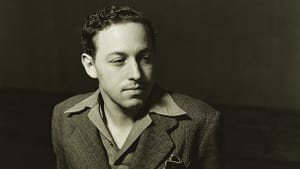Stay in the Loop
BSR publishes on a weekly schedule, with an email newsletter every Wednesday and Thursday morning. There’s no paywall, and subscribing is always free.
Is drama meant to be taken seriously?
Tennessee Williams's 'Stairs to the Roof' (second review)

We have a reverence for serious art. We think there are classics that should not be touched but constantly recreated as they were originally intended. But is that true? Doesn’t each production of a play, an opera, a symphony change in the hands of its performers?
EgoPo, a local nonprofit repertory company, likes to turn expectations on their head, and Lane Savadove’s direction of a rarely produced early play by Tennessee Williams does just that.
Tennessee was a young man, still called Tom, working at his father’s International Shoe Company when he began Stairs to the Roof, a precursor to his later success The Glass Menagerie. He subtitled this play “A Prayer for the Wild of Heart That are Kept in Cages,” and that’s what it is about, people trapped in their daily lives who long for something more while civilization collapses around them. Williams himself had a breakdown after working at the shoe company before moving away and creating a new persona, the one we know as Tennessee.
Spin the wheel and see what happens
Beginning writers need to explore, to question, to write absurd dialogue and odd plotlines, and generally find their way through all the rules of writing plays until they have something authentic to say. Stairs to the Roof is such a play. It is the story of Ben Murphy, played by the engaging Craig O’Brien, a young man trying to break free from what he sees as a mechanistic world of work and marriage and family. “The earth,” Ben says, “is a wheel in the gambling casino of the universe.” He wants to spin the wheel and see what happens.
The play was completed in December 1941, just as the United States was entering the war, but other than a radio broadcast about a battle, the world on stage is an idealized one where dreams are lost and the only hope seems to be to escape and colonize a distant star.
Ben, like Tom himself, like the brother in The Glass Menagerie, is stuck in a monotonous job at Consolidated Shirtmakers to support his wife and their impending child. The workers arrive climbing an invisible staircase carrying their brown bag lunches, then sit and type endlessly (have any of these young actors ever seen an actual typewriter, I wondered) overseen by their bellowing boss, Mr. Gum (Matthew Weil). But Ben has found an escape: He wears cowboy boots and at lunchtime climbs a hidden stairway to the roof where he can breathe.
When work is over, he joins his friend Jim (Michael Pliskin) at a bar as they recall the dreams they had at graduation, only eight years ago. Then he goes home to his wife and their house with white lace curtains, the symbol of ultimate repression.
At his most hopeless, he meets Girl (Lauren Berman) who has just been dumped by her boss, Mr. Thatcher (Dexter Anderson), and together they raid the zoo and free the foxes, played by a pack of mechanical toy dogs. After a night spent free of responsibilities, the two escape to the roof and are transported to a distant star.
What would Williams want?
The production is full of surprises, from the over-the-top performances, to the tumbling scenery, to the landing of an alien spacecraft. And it raises several questions. Is this what Williams intended? With no prior knowledge of the play, it’s hard to know. By extension the next question is: What would it have been like had it been played in usual dramatic fashion?
I took an acting class recently in which we were assigned a scene from Chekhov. Bored with the usual interpretation, we went for farce, and when we were done, the teacher looked at us seriously, and imperiously, and said, “Okay. Now you’ve done that, now let’s do it the right way.” But is there a right way?
Could we find new depths in old plays if we just looked at them differently? All too often, older works reflect societal views at the time. As culture and society change, should plays be updated— or should we see them as relics and treat them with reverence? We only think we know how ancient Latin was spoken or how the Greek plays were performed. The Shakespeare I learned as high art had little to do with the productions I later saw that played to the lowest common denominator.
Perhaps we need to be a little less serious in our productions and a little more adventurous. (Yes, I can see certain playwrights who need final approval of any production of their work glaring at me right now.) I come out of the film and TV world, where the writer’s word is not as sacrosanct as it is in the theater and where, as a writer, I quickly learned that the final collaboration mattered more than the perfect word.
Perhaps the greatest success occurs when the audience leaves with lots to talk about, and that makes this production worth seeing.
For Steve Cohen’s review, click here.
What, When, Where
Stairs to the Roof. By Tennessee Williams. Lane Savadove directed. Presented by EgoPo Classic Theater. Through March 1, 2015 at the Latvian Society, 531 N. 7th Street (7th and Spring Garden St.), Philadelphia. 267-273-1414 or www.egopo.org.
Sign up for our newsletter
All of the week's new articles, all in one place. Sign up for the free weekly BSR newsletters, and don't miss a conversation.

 Naomi Orwin
Naomi Orwin